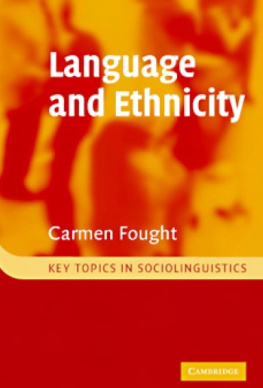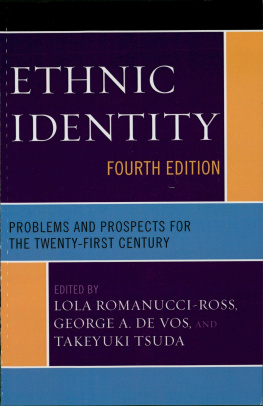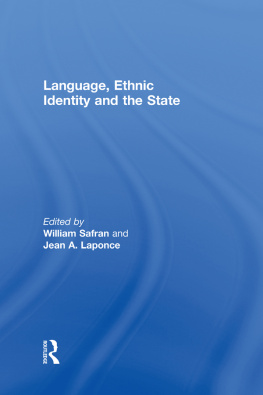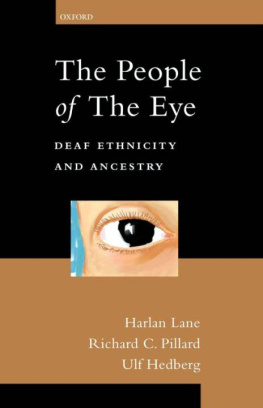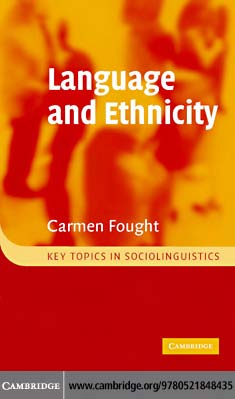
Language and Ethnicity
What is ethnicity? Is there a white way of speaking? Why do people sometimes borrow features of another ethnic groups language? Why do we sometimes hear an accent that isnt there? This lively overview reveals the fascinating relationship between language and ethnic identity, exploring the crucial role it plays in both revealing a speakers ethnicity and help ing to construct it. Drawing on research from a range of ethnic groups around the world, it shows how language contributes to the social and psychological processes involved in the forma tion of ethnic identity, exploring both the linguistic features of ethnic language varieties and also the ways in which language is used by different ethnic groups. The first overview of this important topic, Language and Ethnicity will be welcomed by stu dents and researchers in sociolinguistics, as well as anybody interested in ethnic issues, language and education, intereth nic communication, and the relationship between language and identity.
carmen fought is Associate Professor of Linguistics at Pitzer College, Claremont, California. Her research focuses on issues of language and ethnicity, including the dialects asso ciated with Latinos and Latinas in California, bilingual acqui sition, and language attitudes. She is author of Chicano English in Context ( 2003 ) and Sociolinguistic Variation: Critical Reflections ( 2004 ).
KEY TOPICS IN SOCIOLINGUISTICS
Series editor: Rajend Mesthrie
This new series focuses on the main topics of study in sociolinguistics today. It consists of accessible yet challenging accounts of the most important issues to consider when examining the relationship between language and society. Some topics have been the subject of sociolinguistic study for many years, and are here re-examined in the light of new developments in the field; others are issues of growing importance that have not so far been given a sustained treatment. Written by leading experts, the books in the series are designed to be used on courses and in seminars, and include useful suggestions for further reading and a helpful glossary.
Already published in the series: Politeness ,by Richard J. Watts Language Policy ,by Bernard Spolsky Discourse ,by Jan Blommaert Analyzing Sociolinguistic Variation ,by Sali A. Tagliamonte
Forthcoming titles: World Englishes ,byRakesh Bhatt and Rajend Mesthrie Bilingual Talk ,byPeter Auer
Language and Ethnicit y
CARMEN FOUGHT

cambridg e universit y pres s Cambridge , Ne w York , Melbourne , Madrid , Cap e Town , Singapore , S o Paul o
Cambridg e Universit y Pres s Th e Edinburg h Building , Cambridg e cb 2ru , U K
Publishe d i n th e Unite d State s o f Americ a b y Cambridg e Universit y Press , Ne w Yor k
www.cambridge.or g Informationonthistitle:www.cambrid g
e.org/978052184843
Carme n Fough t
Thi s publicatio n i s i n copyright . Subjec t t o statutor y exceptio n an d t o th e provisio n o f relevan t collectiv e licensin g agreements , n o reproductio n o f an y par t ma y tak e plac e withou t th e writte n permissio n o f Cambridg e Universit y Press .
Firs t publishe d i n prin t forma t
isbn-1 978-0-511-24524- eBoo k (EBL ) isbn-1 0-511-24524- eBoo k (EBL )
isbn-1 978-0-521-84843- hardbac k isbn-1 0-521-84843- hardbac k
isbn-1 978-0-521-61291-3paperbac k isbn-1 0-521-61291- paperbac k
Cambridg e Universit y Pres s ha s n o responsibilit y fo r th e persistenc e o r accurac y o f url s fo r externa l o r third-part y interne t website s referre d t o i n thi s publication , an d doe s no t guarante e tha t an y conten t o n suc h website s is , o r wil l remain , accurat e o r appropriate .
To John R. Rickford and Walt Wolfra m
charismatic colleagues , pioneering contributors to the study of language and ethnicity , and outstanding mentors to generations of other scholar s
Content s
Preface
Acknowledgments
Part IGeneral issues in ethnicity and language
1 What is ethnicity?
Areas of agreement about ethnicity
Possible definitions of ethnicity
Possible definitions of race
2 Language and the construction of ethnic identity
What linguistic resources do individuals have in constructing identity?
Indexing multiple identities
Ethnic pride or assimilation?
How is an individuals ethnicity co-constructed by the community?
Language and the construction of ethnic identity: three individual cases
Part II Linguistic features and ethnicity in specific groups
3African-American groups
What is AAVE?
AAVE grammar
AAVE phonology
Variation in the use of non-standard features in AAVE
Attitudes towards AAVE
Regional variation in AAVE: is AAVE converging toward a supraregional norm?
Another possibility: a blend of supraregional and regional norms
Standard AAE and the language of middle-clas s African-Americans
AAVE in the media
4 Latino groups
4.1 The complexities of identity in Latino communities
Repertoires: multiple codes for multiple identities
Attitudes, choices, and the construction of identity
The structure of dialects in latino communities
Chicano English phonology
Chicano English grammar
The structure of other Latino English dialects
Latino dialects of Spanish
The language gap: differences among generations
5Linguistic variation in other multiethnic settings
Cajuns and creoles in Louisiana
South African ethnic groups
Maoris in New Zealand
6Are white people ethnic? Whiteness, dominance, and ethnicity
The social correlates of being white
The linguistic correlates of being white
The consequences of sounding white
Humor and the portrayal of whiteness
7Dialect contact, ethnicity, and language change
Dialect contact and ethnic boundaries
Influences of minority ethnic dialects on the dominant dialect
Contact among ethnic minority dialects
Ethnic minority group speakers and sound change
Part III The role of language use in ethnicity
8Discourse features, pragmatics, and ethnicity
Indirectness
Turn-taking, silence, and backchanneling
Joking
Complimenting
Acquisition of language norms
9Interethnic communication and languag e prejudice
Tennis, anyone?
Interethnic communication
Differences in language use norms in public settings
Language varieties and interactional styles in the classroom
Teaching a standard variety to speakers of vernacular varieties
Accent hallucination
Matched guise studies and linguistic profiling
Crossing: may I borrow your ethnicity?
Classic studies of crossing in the UK
Who crosses?
Why does a speaker cross?
How does an individual get access to a linguistic code other than his orher own?
How extensive is crossing, linguistically? What linguistic areas are individuals who cross most likely to use?
Does crossing lead to less racism?
Crossing versus passing

